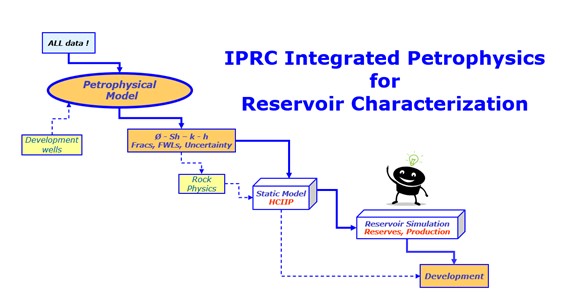Course Details
Home / Public Courses / Course Details
ONLINE: Integrated Petrophysics for Reservoir Characterisation (PPH902)
2-6 December 2024 5 days Virtual instructor-led course, OnlineCourse Fee: 2950 EUR + VAT
Description
This course is the VILT condensed version of the industry standard IPRC course. The course will teach you how to evaluate reservoirs and quickly identify flawed results. Robust petrophysical results are achieved by the logical, systematic integration of all relevant data - new and old - which is extremely cost-effective compared to the errors resulting from a too-focused, fashionable analysis of part data sets. Integration places each data item in its proper context. This replaces the need to run irrelevant logs, explains apparent data conflicts and provides the correct answer faster.
This course, evolved from a PhD in petrophysics and 30 years of consulting and training, demonstrates how robust answers are achieved by the logical integration of diverse data. Pay and reserves are best addressed by disciplined, logical processes for porosity, saturation, permeability and fluid contacts. Low contrast pay, clastics and carbonates are evaluated by straight forward techniques which outperform any log analysis with direct, plain-to-see results. The integration of all relevant data, including PetroDB’s 30,000 core plug database, is clearly mapped out with the crucial Petrophysics to Geomodel checks set out.
This course, presented over 250 times, was the first public integrated petrophysics course (Jan1990) and has been continuously updated with new data and methods to mirror the modern petrophysicist’s real world experience.
Course Structure:
Course Level: Skill
Instructor: Mark Deakin
This course, evolved from a PhD in petrophysics and 30 years of consulting and training, demonstrates how robust answers are achieved by the logical integration of diverse data. Pay and reserves are best addressed by disciplined, logical processes for porosity, saturation, permeability and fluid contacts. Low contrast pay, clastics and carbonates are evaluated by straight forward techniques which outperform any log analysis with direct, plain-to-see results. The integration of all relevant data, including PetroDB’s 30,000 core plug database, is clearly mapped out with the crucial Petrophysics to Geomodel checks set out.
This course, presented over 250 times, was the first public integrated petrophysics course (Jan1990) and has been continuously updated with new data and methods to mirror the modern petrophysicist’s real world experience.
Course Structure:
- 5 modules of 4 hours each, delivered over 5 days
- Optional: Pre-course self-learning module
- Optional: Post-course self learning module incl. Q&A opportunity
Course Level: Skill
Instructor: Mark Deakin

Designed for you, if you are...
- A petrophysicist, geologist, operations geologist, geo-modeller, reservoir engineer, geophysicist or core analyst, with a year’s experience with logs or formation evaluation
Ensure your laptop is loaded with the provided Self Learning modules.
Course content can be adapted to meet the participants' requirements.
How we build your confidence
This course consists of five components to expand and maximise the course content delivery. Content is varied, stimulating and it includes short focused instructor videos; course notes extracts; micro-practicals, cornerstone 4 hour daily VILT sessions; before and after self-learning modules; Question & Answer sessions; industry videos & exercises; comprehensive Petrophysical Toolbox; Petro DB extracts; HPV sensitivities; How to demos; Quizzes & Answers.Before and After Self-Learning Modules
These modules are an important extra component of the course:
- Pre is designed to focus and prepare you for the main VILT session
- Post allows you to practise and quiz yourselves and the instructor before closing out the course
The benefits from attending
This course is a condensed package of powerful integration techniques.It provides a wide array of delivery mechanisms to build a thorough understanding and general template on how to properly evaluate wells and reservoirs.
Topics
- Petrophysical objectives
- Concept of redundancy and data hierarchy - Each major petrophysical output is addressed sequentially with its own
- Objective - problems - data - logging tools - How to calibrate your log analysis
- Vshale & lithology
- Porosity: total or effective?
- Water zones, Rwa’s & formation water resistivity (Rw)
- Saturation including Rt/Ro, m, n, OBM/WBM core; capillary pressure & saturation-height models; NMR Sw’s, facies
- Impact of wettability
- Calibrating Sw
- Shaly sands
- How to integrate resistivity & non-resistivity data
- WaxmanSmits Qv, m*, n* with or without core - Fluid contacts and capillary pressure
- Using MDTs effectively
- Distinguishing the mobile phase - Class dependent: The RockType Master Equation: What is it? How do I use it?
- Permeability
- Rock-types
- NMR
- Bound fluid volume
- Timur-Coates permeability
- How to deliver the correct permeability reservoir simulation input - Netpay
- What is netpay?
- Its proper criteria and evaluation - Key recommendations from drilling mud to effective permeability
- Common errors and how to reveal and avoid them
OPTIONAL: Before and After Self Learning modules:
- Excel Petrophysical Toolbox: Swpc:n calibration, Shaly Sand QL LAS evaluator, 100+ Eqns, PetroDB-Vault extracts, HPV Sensitivities
- Exercises: Quick look log analysis techniques, DST-core-log reconciliation, complete core-log evaluation sequence, MDT operational task
- Course notes
- Micro-practicals
- Short focused instructor videos
- How-to demos
- Quizzes and answers
- Key industry videos
Related Courses
Customer Feedback
"Inspiring instructor, very engaged. Learned a lot, liked the practicals." - Geologist at Aker BP"The information given is highly valuable for my job." - Petrophysicist at Neptune Energy
"This is the best Petrophysics course ever!" - Sr. Petrophysicist at CC Energy Development
"Great overview but also in depth. Good applied practical approach." - Geophysicist at GDF SUEZ
"Mark explains difficult concepts effectively and makes it easy to understand. I am glad that I choose this course!" - Geologist at ADCO
© All rights reserved
HOT Engineering GmbH Tel: +43 3842 43 0 53-0 Fax +43 3842 43 0 53-1 hot@hoteng.com
